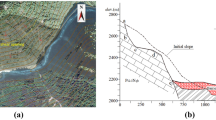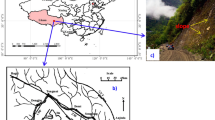Abstract
A double-sided slope with high water content in sandy clay was considered under the action of seismic load. Its failure mode and dynamic response were investigated using a hydraulic servo shaking table test. The typical characteristic of failure mode and dynamic responses of the double-sided slope were analyzed. Experimental results show that slope failure undergoes a process of progressive deformation. The slope failure mode can be explained as creep sliding landslide. AFA (Amplification Factor of Acceleration) at the surface and inner parts of the slope shows an increasing trend with the increase of relative elevation. The relationship between AFA and EAA (Excitation Amplitude of Acceleration) is nonlinear. An empirical formula is proposed to describe preferably the relationship between AFA, relative elevation and dimensionless EAA. The AFA at the middle and upper parts of the slope increases apparently with increasing EFA (Excitation Frequency of Acceleration).
Similar content being viewed by others
References
Arango I, and Seed HB (1974) Seismic stability and deformation of clay slopes. Journal of Geotechnical Engineering Division, ASCE 100 (2): 139–156.
Chen XM, Shen J, Wei P, et al. (2010) Large-scale shaking table test of seismic stability of Xiashu Loess slope: analysis of test results. Journal of Disaster Prevention and Mitigation Engineering 30 (6): 587–594. (In Chinese)
Cruden DM, Varnes DJ (1996) Landslide types and processes. In: Turner AK, Schuster RL (eds.) Landslides investigation and mitigation. Transportation Research Board, US National Research Council. Special Report 247, Washington, DC, Chapter 3, pp. 36–75.
Dong JY, Yang GX, Wu FQ, Qi SW (2011) The large-scale shaking table test study of dynamic response and failure mode of bedding rock slope under earthquake. Rock and Soil Mechanics 32 (10): 2977–2982. (In Chinese)
Fan G, Zhang JJ, Wu JB, et al. (2016) Dynamic response and dynamic failure mode of a weak intercalated rock slope using a shaking table. Rock mechanics and rock engineering 49 (8): 1–14. https://doi.org/10.1007/s00603-016-0971-7
Hardin BO, Drnevich VP (1972) Shear modulus and damping in soils: Design equations and curves. Journal of the soil mechanics and foundation division ( ASCE) 98 (sm7): 667–692.
Huang RQ, Li WL (2009a) Development and distribution of geohazards triggered by the 5.12 WenchuanEarthquake in China. Science China Series E (Technology Science) 52: 810–819. https://doi.org/10.1007/s11431-009-0117-1
Huang RQ, Li WL (2009b) Analysis of the geo-hazards triggered by the 12 May 2008 Wenchuan Earthquake, China. Bulletin of Engineering Geology and the Environment 68: 363–371. https://doi.org/10.1007/s10064-009-0207-0
Huang RQ, Xu Q, Huo JJ (2011) Mechanism and Geomechanics models of landslides triggered by 5.12 Wenchuan Earthquake. Journal of Mountain Science 8: 200–210. https://doi.org/10.1007/s11629-011-2104-9
Huang RQ, Pei XJ, Fan XM, et al. (2012) The characteristics and failure mechanism of the largest landslide triggered by the Wenchuan earthquake, May 12, 2008, China. Landslides 9: 131–142. https://doi.org/10.1007/s10346-011-0276-6
Hungr O, Leroueil S, Picarelli L (2014) The Varnes classification of landslide types, an update. Landslides 11: 167–194. https://doi.org/10.1007/s10346-013-0436-y
Latha GM, Garaga A (2010) Seismic stability analysis of a Himalayan rock slope. Rock Mechanics and Rock Engineering 43: 831–843. https://doi.org/10.1007/s00603-010-0088-3
Lin ML, Wang KL (2006) Seismic slope behavior in a large-scale shaking table model test. Engineering Geology 86 (2): 118–133. https://doi.org/10.1016/j.enggeo.2006.02.011
Ling HI, MohriY, Leshchinsky D, et al. (2005) Large-scale shaking table tests on modular-block reinforced soil retaining walls. Journal of Geotechnical and Geoenvironmental engineering 131: 465–476. https://doi.org/10.1016/(ASCE)1090-0241(2005)131:4(465)
Liu HX, Xu Q, Li YR, et al. (2013) Response of high-strength rock slope to seismic waves in a shaking table test. Bulletin of the Seismological Society of America 103: 3012–3025. https://doi.org/10.1785/0120130055
Liu HX, Xu Q, Li YR (2014) Effect of lithology and structure on seismic response of steep slope in a shaking table test. Journal of Mountain Science 11 (2): 371–383. https://doi.org/10.1007/s11629-013-2790-6
Srilatha N, MadhaviLatha G, Puttappa CG (2013) Effect of frequency on seismic response of reinforced soil slopes in shaking table test. Geotextiles and Geomembranes 36: 27–32. https://doi.org/10.1016/j.geotexmem.2012.10.004
Taylor DW (1937) Stability of earth slopes. Journal of the Boston Society of Civil Engineers 24: 197–246.
Varnes DJ (1954) Landslide types and processes. In: Eckel EB (ed.) Landslides and engineering practice, special report 28. Highway Research Board, National Academy of Sciences, Washington, DC. pp 20–47.
Varnes DJ (1978) Slope movement types and processes. In: Schuster RL, Krizek RJ (eds.) Landslides, analysis and control, special report 176: Transportation Research Board, National Academy of Sciences, Washington, DC. pp 11–33.
Vanapalli SK, Fredlund DG, Pufahl DE, et al. (1996) Model for the prediction of shear strength with respect to soil suction. Canadian Geotechnical Journal 33: 379–392. https://doi.org/10.1139/t96-060
Wasowski J, Keefer DK, Lee CT (2011) Toward the next generation of research on earthquake-induced landslides: current issues and future challenges. Engineering Geology 122: 1–8. https://doi.org/10.1016/j.enggeo.2011.06.001
Wang KL, Lin ML (2011) Initiation and displacement of landslide induced by earthquake- a study of shaking table model slope test. Engineering Geology 122: 106–114. https://doi.org/10.1016/j.enggeo.2011.04.008
Xie W, Zhang DW, Yang S (2017) Impact of moisture content on variation of small-strain shear modulus of compacted subgrade soil. Rock and Soil Mechanics 38 (5): 1273–1280. (in Chinese)
Xu GX, Yao LK, Gao ZN, et al. (2008) Large-scale shaking table model test study on dynamic characteristics and dynamic responses of slope. Chinese Journal of Rock Mechanics and Engineering 27 (3): 624–632. (In Chinese)
Yang J, Sato T, Savidis S, et al. (2002). Horizontal and vertical components of earthquake ground motions at liquefiable sites. Soil Dynamics and Earthquake Engineering 22: 229–240. https://doi.org/10.1016/s0267-7261 (02)00010-6
Yang GX, Wu FQ, Dong JY, et al. (2012) Study of dynamic response characters and failure mechanism of rock slope under earthquake. Chinese Journal of Rock Mechanics and Engineering 31 (4): 696–702. (In Chinese)
Das Braja M (1993) Principles of soil dynamics. Boston: PWSKent Publishing Company.
Zhao SP, Zhu YL, He P, et al. (2003) Testing study on dynamic mechanics parameters of frozen soil. Chinese Journal of Rock Mechanics and Engineering 22 (suppl2): 2677–2681. (In Chinese)
Zhang XD, Liu JS, Lan CY, et al. (2011) Dynamic test analysis of frozen Aeolian soil under earthquake loading. The Chinese Journal of Geological Hazard and Control 22 (2): 135–142. (In Chinese)
Acknowledgments
This study was supported by National Natural Science Foundation of China (Grant No. 10902112), the Fundamental Research Funds for the Central Universities (2682017QY02) and the National Key R&D Program of China (2016YFC0802203), and the Youth Innovation Promotion Association CAS.
Author information
Authors and Affiliations
Corresponding author
Rights and permissions
About this article
Cite this article
Yang, B., Gao, Fp. & Jeng, Ds. Failure mode and dynamic response of a double-sided slope with high water content of soil. J. Mt. Sci. 15, 859–870 (2018). https://doi.org/10.1007/s11629-017-4616-4
Received:
Revised:
Accepted:
Published:
Issue Date:
DOI: https://doi.org/10.1007/s11629-017-4616-4




